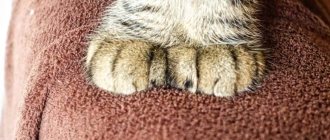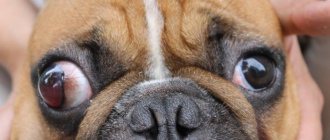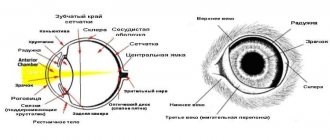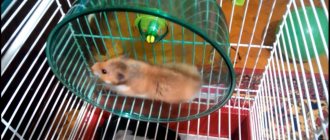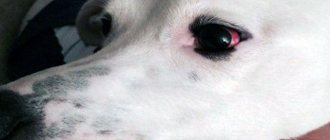Often, when choosing a hamster, people try to find out all the nuances about its health, maintenance, care, etc. This is the right tactic, because it is better to immediately know what we will face in the future. In markets and pet stores you can find a wide variety of breeds of hamsters.
There are both small Djungarians and long-haired Syrians. Occasionally you may see a white hamster with red eyes. Usually such animals scare people and they pass by. After all, such an appearance is associated with congenital pathologies, weakness, and diseases. However, you should not judge a hamster just by its appearance.
In fact, even a hamster with red eyes can be completely healthy and capable of producing good offspring. It is only important to learn how to determine what causes the strange coloring. Below we will help you determine why your hamster has red, although otherwise completely normal, eyes. This may depend on several factors.
Among them, the most common are tiny Djungarian and long-haired Syrian hamsters. A white hamster with red eyes is less attractive and even frightening to humans. This appearance gives rise to false assumptions about the disease and pathologies of the animal. But here it is important not to rush to conclusions and figure out why the hamster has red eyes.
Most often, the red-eyed hamster is absolutely healthy and ready to give the same strong offspring. The main thing is the ability to determine what contributed to such an unusual color. Below it will become clear exactly how to do this and you can easily figure out on your own why the hamster has red eyes. There are no other oddities in these eyes, only the color. So, there are several factors that influence color.
Breed characteristics
You need to start with one simple fact: red eyes in hamsters do not in all cases indicate an illness in the animals.
Moreover, many breeds of rodents have such eyes initially (more precisely, this is a consequence of selection work). In these cases, “redness” is just breed characteristics:
- Campbell's hamsters. Not all of them, but only some color varieties (light, including sandy and amber).
- Many other hamsters with gray, brown, white coloring, as well as in the “ivory” variants, have red eyes.
There are exceptions too. For example, among “jungarians” this coloring of the cornea is not found at all, with the exception of albinos. However, it is impossible to describe all possible breed variations within one article. If there are doubts related to the coat color and eye color of the animal, consultation with an experienced breeder is necessary.
In particular, there is a classic situation when the same Campbell hamsters are passed off as Djungarian hamsters. So, if in the first case animals have red eyes and this is allowed by breed standards, then in principle Djungarians cannot have red eyes.
What should you be wary of?
Hamster diseases can also answer the question - why does a hamster have red eyes. This applies to animals that do not initially have white fur, so it is necessary to take your pet to a veterinarian for examination.
In this case, treatment is most often required, because redness and swelling may indicate not only mechanical irritation, but also be a manifestation of diseases of other organs.
An obvious ailment is the animal's blindness - congenital or acquired. It can be diagnosed independently: the rodent moves little, and the eyes fester or swell. If you consult a doctor at the initial stage, vision can be restored with medication.
But this is not the only danger. The protrusion of the eyes of these animals causes infections to enter the body. Even walking through a dusty room or living in unkempt cages for hamsters causes conjunctivitis.
- eye redness and swelling;
- purulent discharge;
- drowsiness and lethargy of the animal.
Self-treatment without a medical examination can only worsen the situation. It is better to take care of your pet using other methods: clean the cage and wheel with antiseptic solutions and provide proper nutrition (whole grains and chicken meat). Use special eye drops at the prescribed time as prescribed by your veterinarian.
Here they are - breeds of hamsters with red eyes. If you were wary of them before, now you know that this is a rare gift, and you will be lucky enough to become the owner of an albino.
In scientific terms, albinism is a mutation in the body that is characterized by the absence of a special pigment in the cells of the skin, fur and eye shell (popularly known as melanin). Representatives of rodents of any breed can become albinos. To provide quality care to such special babies, you need to better understand the nuances of their body structure.
In the wild, there are hamsters of a wide variety of colors, ranging from black to unusual golden shades of fur.
Due to the fact that the white color of the fur coat too clearly attracts the attention of large predatory animals, it is quite rare in nature. A snow-white rodent may be a Djungarian, a Syrian, or a representative of another, less common breed of hamster
Breeders have put a lot of effort into developing a breed of hamster with a perfectly white coat. Attempts for a long time were unsuccessful, and when crossed, the offspring were too weak to survive. After a little time, the breeders were still able to breed an individual that met all the necessary criteria.
Pedigree snow-white hamsters are very popular among experienced breeders. At the same time, a rare coat color can be a consequence of both albinism and animal selection. This is a kind of mutation, as a result of which the previously mentioned melanin is absent in the animal’s cells. The animal's famous red eyes are also the result of a genetic mutation.
Albino hamsters with red eyes
The “classics” are albino hamsters with red eyes. In their case, the red color of the cornea is absolutely normal and does not pose any danger to the health of the animal. This color is due to the fact that blood vessels are visible through the pigment-less cornea.
It is generally accepted that animals with red eyes are necessarily blind from birth, but this is not at all true. In most cases, “red eyes” do not have problems with vision. Moreover, blindness is weakly associated with eye color. If blind animals regularly appear in the litter of animals, then such producers should be excluded from the reproduction process due to the presence of some defective genes.
Color
The first thing you should pay attention to when purchasing a small rodent is the color of its coat. Let's look at every color detail that helps determine the rodent breed.
Dzhungarik's wool is colored in dark shades of brown, black and gray. The fur of its dwarf relative is colored in sand and amber shades; there are also black representatives of the species. If Djungarian hamsters are dark brown, the Campbell hamster has light shades of brown. In 99% of cases, Dzungarik has a diamond on his head. Depending on the color of the coat, it can be clearly outlined or almost merge with the main color of the coat. It is most clearly drawn on the head of brown rodents. In gray animals it is barely visible. Look at your pet's sides. Dzungariks have clearly defined arches between their back and stomach. The Campbells also have them, but their outlines are not so pronounced
They practically merge with the main color of the coat. The last thing to notice is the stripe on the back of the pygmy rodent. It is present in both breeds, but in Dzungariks it has clear boundaries, and it is also quite wide at the withers.
The Campbell's hamster has a thin dorsal stripe, almost invisible in the lower part of the body.
Campbell rodents come in a wider variety of colors. Among the pets there are albinos, animals with Argentine and Agouti colors, spotted and gray rodents, etc.
Red eye diseases in hamsters
Any diseases or pathologies associated with red eyes in hamsters are fraught with the development of blindness, and a blind pet will have a significantly reduced level and life expectancy.
Blindness
Blindness is not a disease, but a consequence of a disease. For example, blindness accompanied by severe redness of the eyes is often the result of blows that burst blood vessels.
Due to the “blood filling” of the cornea, light cannot reach the lens, causing the animal to lose vision. If the mechanical impact was not strong, then this may be a temporary phenomenon. Otherwise, the hamster may lose not only its vision, but also the eye itself.
Hemorrhages and the appearance of a red color can be accompanied by many parasitic diseases and inflammations of infectious origin. Getting caustic and toxic substances into the eyes leads to the same results. Because of this, when a hamster roams freely in an apartment, it is necessary to carefully isolate household chemicals and other potentially dangerous reagents from the animal’s possible access.
In all these cases, the following symptoms quickly develop:
- The hamster begins to behave strangely, constantly bumping into objects around him.
- For the first few days, the animal constantly squeaks and shows other signs of anxiety.
- The eyes become red and cloudy.
- If you look closely, you can see how often the animal began to sniff and generally rely solely on its sense of smell.
Treatment depends directly on the underlying cause of blindness. Anti-inflammatory, antiparasitic, antifungal drugs can be prescribed; specialists resort to washing the conjunctival cavity with antiseptic compounds, etc.
Infections
A very common cause of red eyes is infection. As a rule, redness and swelling are a 100% sign of conjunctivitis. The causes of inflammation in this case can be extremely varied:
- The conjunctival cavity becomes very red and swollen , the hamster becomes “narrow-eyed”, acquiring a thoughtful squint. • Very often, discharges appear from the eyes, the nature of which is associated with the type of inflammatory process (pus - with purulent, serous fluid - with serous, etc.).
- A characteristic sign of conjunctivitis in many cases is redness of the eye with the simultaneous development of photophobia (photophobia). The hamster squints at the sight of any light, and if you shine a flashlight on it, it tends to run away into the house. This is due to severe irritation and soreness of the mucous membranes.
- If the inflammation is severe, the animal feels unwell , eats little or refuses food altogether, quickly loses weight and may well die due to severe exhaustion.
Non-communicable diseases
Non-contagious diseases of Djungarian and other breeds of hamsters primarily include injuries. They are injured mainly due to the fault of their owners. Rodents should not be allowed to walk on a table or other surface from which the homa could fall. When purchasing and installing a running wheel, it is necessary to exclude narrow (less than 0.5 cm) gaps so that the baby does not stick his paw in there and injure himself. If you have several dwarfs, place them in different cages. Otherwise, they will fight and may also injure each other.
Poor nutrition may be the cause
- dental diseases;
- inflammation of the cheek pouches;
- food poisoning;
- hemorrhoids (if blood drips from the anus, your pet may have a fissure there).
Non-communicable diseases also include complications of pregnancy and pathological childbirth in females. Sometimes blood under the female's tail appears as a result of a miscarriage.
Causes of red spots around the eyes
Sometimes it happens that it is not the eyes themselves that become red and swollen, but only the skin around them. What are the causes of red spots around the eyes? In many ways, predisposing factors are in one way or another associated with other ophthalmological diseases:
- Very often, redness of the skin is explained by the irritating effect of the inflammatory exudate that flows from the eyes during conjunctivitis.
- In addition, many eye pathologies are characterized by severe itching and other unpleasant sensations, due to which the animal constantly rubs its eyelids and the skin around them with its paws. Simply put, redness is a consequence of rubbing and scratching.
List of necessary things for an animal
For a comfortable life for an albino hamster, the necessary minimum of things must be present in its cage, namely:
- Bedding, which can be simple sawdust. The hamster will be able to move around somewhat, in addition, they are safe for health;
- The hamster needs a house as a personal space where he can retire and hide from the light;
- In order to wean your pet from using the toilet in a cage, you need to place a special container that can be easily purchased at a pet store;
- Mineral stones will help your rodent grind his teeth easily. For such purposes, you can purchase a mineral type stone. If you have doubts about your choice, you can consult a sales consultant.
When purchasing equipment for rodents, it is important to remember that the cage must contain more than just the listed minimum. Rodents need exercise equipment to stay active. For such purposes, the following options for simulators for cells of different sizes are suitable:
- wheel;
- hammock or tunnel of varying complexity;
- snags and branches on which it will be convenient for the rodent to climb.
If the rhythm of life of the animal owner does not provide for a nighttime wakefulness, then it is not recommended to place a cage in the bedroom. Hamsters are active at night and their noise will disturb the owner's rest.
Experts recommend covering the bottom of the cage with granular filler. Cotton wool and sawdust are not suitable in this case; the rodent will get its paws stuck in them, which will complicate movement. If you use sawdust, it will scatter around the room from the cage. Care for this type of rodent must be of high quality and timely. Otherwise, the owner’s negligence can lead to illness in the animal.
For the same reason, you should try to monitor the quality of the water in the drinking bowl and change it in a timely manner. It is worth periodically changing the contents of the house. If the hamster’s food, which he carries there by nature, begins to rot there, then the animal may simply be poisoned.
Bathing pets in water is strictly prohibited. Their delicate bodies react negatively to sudden temperature changes. The natural behavior of rodents is facilitated by their natural wool cleaning skills. For a bath, some owners leave river sand filler in the cage.
Eye care for hamsters
Proper eye care for hamsters can help prevent or solve many problems:
- The pet should be examined regularly. If you notice signs of something wrong, it is better to immediately contact a veterinarian.
- Representatives of long-haired breeds need to trim the hair around the eyes to prevent hairs from getting into them.
- Do not use bedding material of questionable quality, since saving on bedding often even leads to the death of animals (including from poisoning and ingestion of foreign objects).
- If during a visual examination foreign bodies (sawdust or something similar) were found in the animal’s eyes, you can try to get rid of them yourself. This requires the smallest syringe and sterile, warm saline solution. With their help, carefully spreading the pet’s eyelids, they carefully wash away the debris.
Prevention
Knowing that rodents are predisposed to eye infections, you need to take care of prevention:
- once a year examination by a ratologist;
- cleaning the cage and room with the addition of disinfectants once a month;
- creating a healthy diet;
- adding vitamin complexes;
- daily change of water and cleaning of drinkers and feeders.
It is important to limit the animal’s free movement around the house. It is necessary to prohibit children from feeding their pets with prohibited foods. After direct contact with an animal, you should wash your hands with soap. Under such conditions, the owner will be able to ensure the health of the animal for a long time.
Conjunctivitis
Both of these diseases are extremely dangerous and require timely treatment. Of course, you should contact a clinic to make a diagnosis and prescribe therapy. However, if this is not possible, then you can recognize diseases and cope with them yourself.
The main signs of developing conjunctivitis are:
- yellow or green pus with a specific odor that accumulates in the corners of the eyes and causes them to stick;
- inflamed eyelids, noticeable swelling or swelling;
- hair loss around the organs of vision;
- temperature, general weakness, apathy and lack of appetite.
The hamster constantly keeps his eyes slightly squinted or does not open them at all. The animal is so apathetic that it can simply lie there, not reacting to light, braking, or tasty food.
For treatment you need to use Albucid eye drops. The medicine needs to be instilled three times a day. Recovery takes from three days to a couple of weeks. The timing depends on how advanced the disease is, the general state of health, and the age of the hamster.
Oral and dental diseases
Hamsters, like any rodents, grow their incisors throughout their lives, so owners should pay special attention to oral hygiene and the animals' teeth. If the pet does not grind down its teeth, this will lead to injury, damage to the oral mucosa, the development of acute inflammation, the formation of abscesses, and abscesses.
Pathologies and dental diseases in Djungarians and Syrians are manifested by redness of the mucous membranes, hypersalivation, decreased appetite, weight loss, abnormal growth, deformation of the incisors, and inflammation of the cheek pouches.
Inflammation of the cheek pouches is one of the most commonly diagnosed pathologies. It is characterized by inflammation, prolapse (prolapse), and the appearance of pathological formations. The disease develops due to injury to the oral mucosa. With this pathology, the animals behave restlessly, rubbing their cheeks and muzzle with their paws. Appetite decreases. Saliva flows from the mouth. As a rule, the pathological process affects the inner surface of the cheeks.
Long incisors provoke dental diseases in hamsters
To relieve inflammation, you need to rinse your pet’s mouth with an antiseptic solution or chamomile decoction. To normalize digestion, give your hamster probiotics and enzymes.
For neoplasms, surgical treatment, restorative, and symptomatic medications are prescribed.
If your hamster has inflamed cheek pouches, treatment should be carried out by a veterinarian. The specialist will carefully turn out the cheeks and clean them of food debris. Inflammation will be relieved by bactericidal drugs, antiseptics, and medications for local and general treatment. After therapy, the hamster must be kept on a fasting diet for 12–14 hours.
